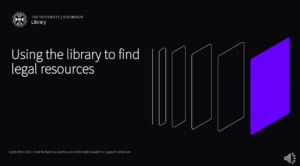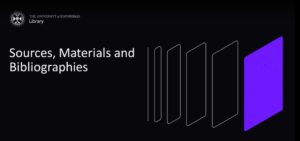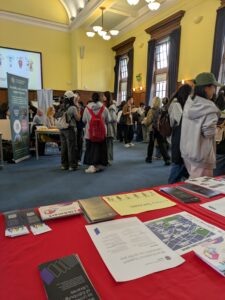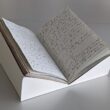Home University of Edinburgh Library Essentials
January 7, 2026
Welcome to the Library! Recordings and slides
Now that everyone is settling in to the new semester, we wanted to remind all students and staff that there is lots of material to help you use library resources for study and research.
In Week One we held live online sessions for PGT and PGR students, recordings of which can be found on the Law Librarian Media Hopper Channel:
If you missed them please feel free to use the videos to catch up, or download the slide decks attached to each video.
Last week we also ran an in-person on campus session for UG students. Although we didn’t record the session, you can find the slides for each part of the session below, or you can watch the PG session above for a similar introduction to library services.
UG Using the Library 2025-2026
Using Legal Databases – 2025-2026
If you require these documents in a different format please contact us by email: law.librarian@ed.ac.uk.
You can also contact us to book an individual appointment for a 30 minute one-to-one session where we can help with finding resources for research and study, referencing and making the most of library resources. Booking is available via the MyEd events booking system, or you can use the following links to find available time in our diaries.
Anna’s appointment booker
SarahLouise’s appointment booker
We look forward to hearing from you!
What AI did next : exploring AI’s role in European theological libraries
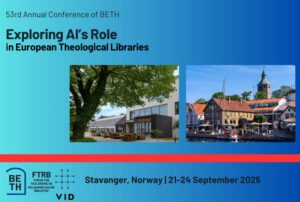
I was privileged to attend the BETH = Bibliotheques Europeennes de Theologie conference in Stavanger, Norway, 20-23 September 2025, which had the theme of exploring AI’s role in Theological libraries. I really appreciated the practical nature of many of the papers in this conference, which highlighted projects and processes using AI that had been implemented in libraries. I also felt that there was also a second theme or undercurrent, that of highlighting the human value of libraries and the books they contain.
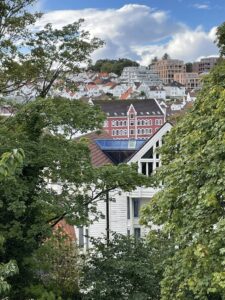
View down into Stavanger
Before we dived into AI, there was a walking tour of Stavanger, starting at Stavanger Cathedral, the oldest cathedral in Norway at 900 years old. Stavanger is located in what is known as the ‘Bible Belt’ of west and south Norway, and used to be called the mission city of Norway because it sent out so many missionaries. I was impressed by several richly detailed epitaphs with paintings of the deceased with their family. Our tour also took in St Peter’s Church, a more ‘regular’ Norwegian church, where a rehearsing worship band created an atmospheric visit. Our last ‘church stop’ was at a historic ‘prayer house’, an upstairs room used as a meeting room by non-conformist churches that sprang up after the Dissenter Act in 1845 allowed Christian gatherings other than the established Church of Norway. Today it is used as a youth church meeting place by the Church of Norway. Our tour took in Stavanger’s streets of painted wooden houses, harbour and hilltop views. We ended up at the conference location, VID Specialised University, where we were greeted by lovely Norwegian waffles and coffee.
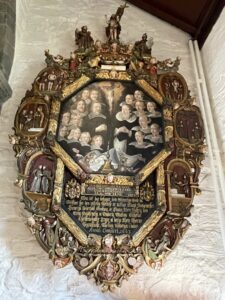
Historic epitaph, Stavanger Cathedral
The first day of the conference closed with a film showing of Le Poids des livres : la bibliothèque de Port-Royal. In preparation for the Bibliothèque de Port-Royal’s move to new premises in 2022-23, two filmmakers, Camille de Chenay and Adrien Pierre, followed the life of the library for six years. The documentary film that resulted is a love song to the library and a powerful piece of advocacy about the value of the library and the human stories it holds and creates. It’s not currently available on YouTube as it’s being shown at film festivals but it should be in the future – I really recommend that you watch it!
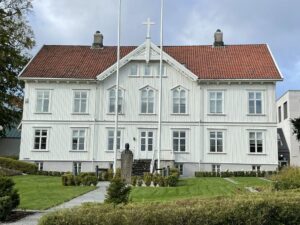
Historic Mission school building, VID Specialized University
Hannah Pope from VID Specialised University kicked off the papers about AI by exploring the role of the librarian. She suggested that we may feel saturated by suggestions about AI, and be struggling between knowing that it is important but also hearing that it is problematic. AI is a tool – or rather, a whole bunch of them – but the difficulty is that we may not be able to pick up and put down that tool at will. It’s appearing all the time in our environment, in a “gold rush” of AI not necessarily in our control. Ignoring AI is no longer an option. We are still in the early stages of understanding AI, and it is similar to the advent of the World Wide Web, so it could be argued “That all turned out fine.” But AI – Gen AI – is an explosion, of bots, deep fakes, and disinformation. Often in the library we’re expected to be ambassadors for AI, but often conversations around AI lack nuance and understanding of the complexities – there is a role for the information professional here. Librarians are ideally positioned to have a foot in both camps, to challenge and adopt.
Data Management Training – Autumn 2025
University of Edinburgh courses are now available to book on all topics dealing with research data management. Aimed at postgraduate research students and academic staff, these four courses are taught by experts from the Library’s Research Data Support team, and cover all aspects of managing digital data for a research project. Each course is offered multiple times during the term, at different campus locations and online.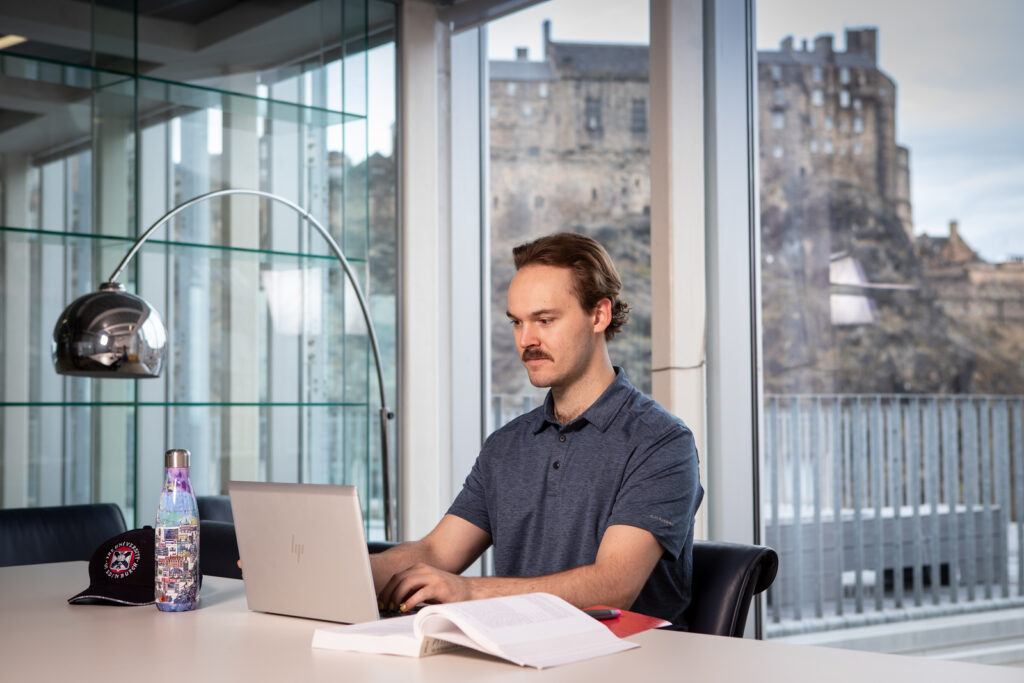
If you are new to concepts of research data management (RDM) you may wish to take the “Data Management for your Research” overview course (1.5 hours). You will be able to apply basic RDM skills to your daily research practices and understand what the FAIR principles (Findable, Accessible, Interoperable, and Reusable) mean and why they matter.
“Writing a Data Management Plan for Your Research”: in this interactive two-hour workshop you will understand the basic components of good DMP, and will produce a first draft Data Management Plan (DMP) for your research project using a tool called DMPonline.
Building on the University’s online Data Protection training, “Working with Personal and Sensitive Data” will prepare you for the challenges of dealing with human subject and other types of confidential data: how to collect, share, store and protect your data safely and securely, and what university services are available to help you (two hours).
“Archiving Your Research Data” (1.5-2 hours) helps you to plan ahead to when your  research project is approaching completion and it is time to find an appropriate repository to share or safeguard the underlying data for your paper, thesis or dissertation for the long-term. You will gain familiarity with using the University’s open acess data repository, DataShare, and know about an alternative restricted access solution, DataVault, as well as how to identify other appropriate repositories. If you are unable to attend any of these scheduled Archiving Your Research Data workshops, you can request additional sessions via our online form: Request training: Archiving your Research Data.
research project is approaching completion and it is time to find an appropriate repository to share or safeguard the underlying data for your paper, thesis or dissertation for the long-term. You will gain familiarity with using the University’s open acess data repository, DataShare, and know about an alternative restricted access solution, DataVault, as well as how to identify other appropriate repositories. If you are unable to attend any of these scheduled Archiving Your Research Data workshops, you can request additional sessions via our online form: Request training: Archiving your Research Data.
All of the above courses are available to book through our scheduled workshops web page: Research Data Service – Scheduled workshops.
Robin Rice
Data Librarian and Head, Research Data Support
New(s) to the Library : More digital newspaper archives
I’m pleased to let you know that following successful trials, the Library has been able to purchase two new digital newspaper archives. Expanding our already extensive collection of digital newspaper archives from the UK and around the world.
The Sunday Times Historical Archive, 1822-2021
Changes to Library Opening Hours
From 15 September 2025 changes will be made to the opening hours of some of our libraries, these changes are set out below. Please check the library opening hours webpage for full details of all library opening hours.
- Semester opening times of four site libraries – Law, ECA, Moray House, Noreen and Kenneth Murray – will be: Monday to Thursday 9am-8pm; Friday 9am-5pm (9am-7pm for Law and Noreen and Kenneth Murray)
- New College Library will close at 5pm Monday-Friday
- Weekend opening hours of the following libraries – Law, ECA, Moray House, Noreen and Kenneth Murray and New College – will be standardised to 12pm-5pm.
- Art & Architecture Library will close for University vacation periods.
Changes at the Western General Hospital Library
The Western General Hospital Library will convert to a self-service Student Study Area from 1 September. The EdHelp service desk and Library will close at 5pm on Friday 22 August, and the small book collection will be moved in the week of 25 August.
Changes at the Main Library
From 1 September, the EdHelp service desk in the Main Library will close at 7pm weekdays and 5pm weekends. This does not affect the opening hours of the Main Library itself, which remains open 24×7.
Feedback
These changes are being made based on analysis of library and service usage and will allow us to provide a more effective service. Comments and feedback from users (both staff and student) can be directed through the normal channel at Information Services Feedback Form | Help | Information Services
Hans Christian Andersen
This month is the 150th anniversary of Hans Christian Andersen’s death. To mark the occasion, Ash Mowat, a volunteer in our Civic Engagement team, has written this blog post, exploring some of Andersen’s works. What is your favourite Hans Christian Andersen tale?
In this blog we shall be exploring two bound and illustrated edition copies of poems by the celebrated, prolific and beloved author of fairy tales the Danish writer Hans Christian Andersen, held at the University of Edinburgh’s Centre for Research Collections.
Brief biography of Hans Christian Andersen
Andersen (2nd April 1805 to 4th August 1875) was born into a modest upbringing, but had been encouraged by his father from an early age to enjoy reading literature.[1] His family situation suffered a tragic loss and further financial decline when his father died when Hans was just aged 11. He received a basic education at a school for poor children until the age of fourteen, and after this initially sought to seek employment in the theatre as an actor or singer, given his artistic talents and interests.
He later returned to more formal education at a grammar school funded by a benefactor of the Royal Danish Theatre in recognition of his talents for writing, especially in the medium of poetry. Andersen would later write record that these later years in education were a miserable time for him in that he was mistreated and discouraged from his favoured ability at creative writing, and also due to the fact that he felt an outsider and misfit due to his family’s poverty. He was also considerably older than the other pupils in his classroom.
He began writing his first stories whilst still at school in the early 1820’s but his first series of fairy tales were published in three volumes between 1835 to 1837. Although initially not very well received critically in Denmark, he would reach success and return to write several more collections of his fairy tales, in addition to authoring novels and travelogues recounting his tours of Europe.
Andersen came to befriend the fellow writer Charles Dickens as they both shared a mutual respect for each other’s work and held similar views on the prevalence and cruelty of poverty, although their friendship later came to an abrupt end to Andersen’s consternation. In his diaries and letters Andersen first wrote of his disinclination to have sexually intimate relationships, then later wrote of his sexual attraction towards men, although the exact nature of his sexual inclinations is uncertain as he was cited as having unrequited attractions for women.
The first booklet of his poetry that I viewed at the University was an illustrated edition of the Ugly Duckling from 1950, that had been created and illustrated by Ann Restall in the Book Production class at the Edinburgh College of Art, with line blocks by Messrs Hislop and Day.[2]
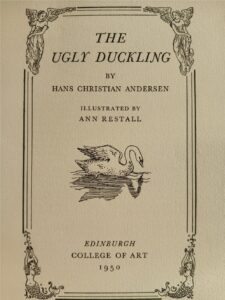
The Ugly Duckling itself was composed by Andersen in 1844, and is one of his most well-known fairy tales which includes many of his recurring themes of feelings of exclusion or the notion of being an outsider or misfit. The location is the countryside in summer and there is a delightful description of the birth of a group of ducklings, each of which are given a voice to articulate their amazement at emerging into life and the expanse of the new environment around them. “Their mother let them look as much as much as they pleased, because green is good for the eyes”, and “how wide the world is”, one of the ducks observes.
The last duckling to emerge is reluctant and also the largest and its mother grows increasingly tired and frustrated at the burden it is placing upon her. When it finally emerges from its shell it is announced as being “frightfully big”. Its mother begins at first to accept the latest arrival but in a series of encounters with other ducks and animals it is repeatedly described in pejorative terms as being ugly, monstrous, ungainly, queer, and mocked and bullied for its strangeness. The impact of the onslaught of these insults affects the ducking so much that it perceives itself as loathsome, unwanted and despised and for those reasons elects to escape and wander on its own. On its travels the duckling encounters a gaggle of Geese who address him as comrade and invite him to join them, only for the geese to be slaughtered by a group of hunters. When the hunter’s dogs’ approach but then ignore the duckling, it remarks “I am so ugly that even the dogs won’t bite me.” As winter approaches, the ducking’s sense of isolation and exclusion are emphasised in the metaphor of the water freezing over to encircle and entrap him. Further such negative encounters follow, but as if to spare the young readers anguish Andersen simply interjects “but it would be too sad to mention all the privations and misery it had to go through during the hard winter.”
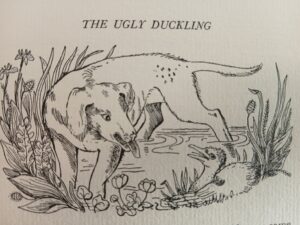
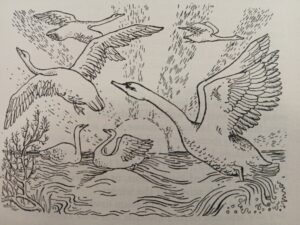
With the advent of Spring, relief and hope come to the rescue as the duckling on seeing his reflection realizes that he is in fact a Swan and he is accepted and welcomed into a family of Swans. The final moral to close the story is “he was so happy, but not at all proud; a good heart never becomes proud.” Across the story we hopefully learn not to judge one another on appearance and not to be cruel and unkind. It also reflects some of the author’s own recorded experience of being bullied at school and not fitting in because of his poverty and being much older than his classmates, and because of his own concerns about his appearance, not being conventionally handsome like many male characters in his tales.
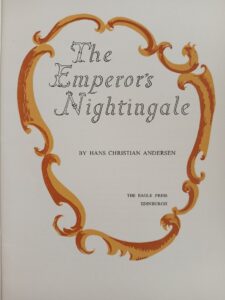
(The image above is from the cover of the second bound story “The Emperor’s Nightingale”, printed in the letterpress department of the Heriot-Watt College, designed and illustrated with lino-cuts by Margaret Jean Mackenzie).[3]
“The Emperor’s Nightingale”, or sometimes simply entitled as “The Nightingale”, was first published by Andersen in 1844. It opens with a stunning and immersive description of the grand palace and gardens of the emperor, to help ensure to ensnare young readers or listeners to the tale being read such that they are immediately transported and enchanted from the start.
As lavish as the palace is with its gold and treasures, they are nevertheless lifeless materialistic items and a gaudy and perhaps vulgar display of wealth. Even the gardens, whilst truly beautiful, were carefully manicured into unnaturally ordered designs at the emperor’s instructions, diminishing the true random assortments in which flowers and trees would form in the wild. By contrast the subject of the Nightingale surpasses all the vanity and contrived array of the palace and its grounds, simply by its natural plumage and the sweet melody of its singings which delights all who experience it. Such is the impact of the Nightingale’s song and its enchanting effects, is that people from across the world come to witness it for themselves. Not having heard of even being aware of the bird, the emperor petulantly demands that it be brought before him to sing in his palace, rather than to hear it where it thrives in the forest.
It is the humbler people working on the estate that have heard the Nightingale and know where it lives, and a kitchen maid leads a group to seek it out to bring before the emperor, although she cautions “it sounds best amongst the trees”. The Nightingale agreed to the invitation, perhaps in truth more of a summons, to sing before the emperor in his home, and when he did the emperor wept tears of joy in witnessing its voice.
Still associating true values as being prized objects and not nature or good deeds, the emperor offers the Nightingale a gold slipper to wear around its neck. The Nightingale refuses this ludicrous adornment remarking that it is reward enough that its singing brings pleasure to others. Not having yet learnt his lesson, the emperor orders the construction of a bejewelled mechanical nightingale which became a thing of worship despite its inferior voice, and the real bird returned to its life in the forest.
After some years the emperor fell gravely ill and the toy bird was no help to him. The real nightingale returned to sing again before the emperor and in doing so healed and restored him to full health. The emperor offered to destroy the toy bird and have the nightingale live at his side in the palace. The nightingale instead agreed to visit and sing before the emperor as often as needed but that he must live within the forest as that is his world and without his natural environment his voice would be stilled.
In essence therefore, this tale cautions against the coveting and valuing of material things over nature, love and simple kindness. Andersen wrote frequently of people of royalty and opulence in his fairy tales, and in this instance the emperor has an epiphany to learn that the true wealth is life and not possessions. There is at times some ambivalence in how Andersen chooses to portray people of wealth, perhaps stemming from the conflict between his own impoverished upbringing and the later fact that he benefited from a sponsor to fund his own education.
These two stories are excellent examples of why Andersen’s tales continue to be loved and read, given that in addition to delivering moral messages, they are also engrossing and entertaining so as not to become dry or dogmatic in tone. The artists’ illustrations also help bring the works to light.
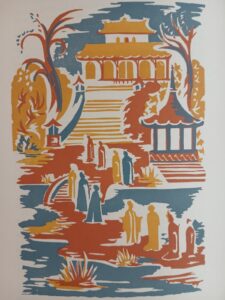
(A finely illustrated page from the book depicting the palace at the summit, leading down thought the gardens onto the sea, its muted colours and simplistic lines helping to convey the moral of the story).
I should like to thank my supervisor Laura Beattie (Community Engagement Officer, University of Edinburgh) for her advice, guidance and support, and all the staff at the University of Edinburgh Centre for Research Collections for their kindness and expertise in enabling me to view these items from the archive.
[1] Hans Christian Andersen – Wikipedia
[2] Booklet containing The Ugly Duckling (2 copies), 1950 | University of Edinburgh Archive and Manuscript Collections
[3] https://archives.collections.ed.ac.uk/repositories/2/archival_objects/29433
An ever-green collaboration: working with the University of St Andrews to identify arsenical bookbindings
In this post conservator Amy Baldwin talks about working with the University of St Andrews to help develop their new arsenic identification tool.
SCURL Conference 2025: increasing inclusion
To add to our recent schedule of conference reports, last month several members of our

The ‘Sir Duncan Rice Library’, University of Aberdeen by Stanley Howe, CC BY-SA 2.0 <https://creativecommons.org/licenses/by-sa/2.0>, via Wikimedia Commons
team attend the Scottish Confederation of University & Research Libraries (SCURL) Conference on the 19th of June, which took place in the striking Duncan Rice Library at the University of Aberdeen.
We were delighted to see that the conference had such an interesting programme focused on the great work member teams are doing across the country to promote inclusivity and diversity of access. Sessions included topics such as ‘Radical Hospitality: how can academic libraries support seekers of refuge?’ and ‘Higher Education librarians and social class background’. There were poster presentations from various member libraries taking action in their own settings, and keynotes from Dr Rachel Shanks, Interdisciplinary Director for Social Inclusion and Cultural Diversity at the University of Aberdeen as well as Beth Hellen-Montague, Head of Library & Information Services, The Frances Crick Institute and author of Practical Tips for Equality, Diversity and Inclusion in Libraries (which is available as an ebook via DiscoverEd).
While all the talks were valuable, Beth spoke very knowledgeably on the practical work of becoming an EDI focused librarian, and while much of what she had to say regarding taking action (that all actions help, we don’t need one person doing inclusion perfectly but rather to take advantage of the positions, groups and access we already have), she also introduced new-to-us concepts such as the Academic Wheel of Privilege which we plan to consider in our future work. This can help us in making assessments regarding building our collections, but also how we approach the cultures around our educational systems and student backgrounds. It also links directly to the work Darren Flynn discussed in his session on social class in academic librarianship.
For more information about the Academic Wheel of Privilege and how it can be used for research, see the FORRT website.
We love to see a strong EDI strand in any conference we attend, and look forward to bringing our learnings from this event to discussions at our ASL EDI group and the wider L&UC EDI network too.
SarahLouise McDonald & Rania Karoula
Academic Support Librarians
Collections
 Hill and Adamson Collection: an insight into Edinburgh’s past
My name is Phoebe Kirkland, I am an MSc East Asian Studies student, and for...
Hill and Adamson Collection: an insight into Edinburgh’s past
My name is Phoebe Kirkland, I am an MSc East Asian Studies student, and for...
 Cataloguing the private papers of Archibald Hunter Campbell: A Journey Through Correspondence
My name is Pauline Vincent, I am a student in my last year of a...
Cataloguing the private papers of Archibald Hunter Campbell: A Journey Through Correspondence
My name is Pauline Vincent, I am a student in my last year of a...
Projects
 Cataloguing the private papers of Archibald Hunter Campbell: A Journey Through Correspondence
My name is Pauline Vincent, I am a student in my last year of a...
Cataloguing the private papers of Archibald Hunter Campbell: A Journey Through Correspondence
My name is Pauline Vincent, I am a student in my last year of a...
 Archival Provenance Research Project: Lishan’s Experience
Presentation My name is Lishan Zou, I am a fourth year History and Politics student....
Archival Provenance Research Project: Lishan’s Experience
Presentation My name is Lishan Zou, I am a fourth year History and Politics student....

